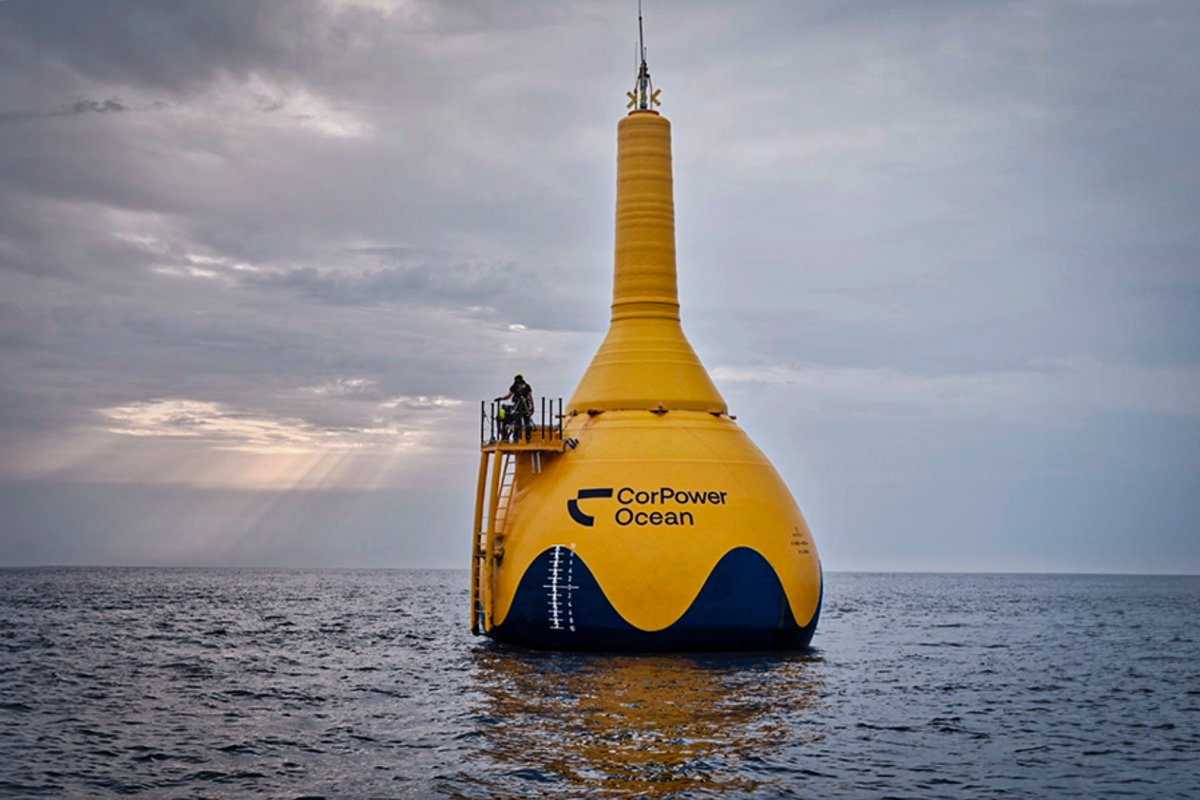
This is worth paying attention to because it nicely increases amphlitude which means a superior power stroke drawing much more energy from the applied work.
this likely improves as we scale upwards as well. and like those windmills, we can place millions in the ocean.
this is starting to look good and do recall that every wave picks up energy from massive amounts of applied wind, so the potential is possibly way larger than on first blush.
Numbers may still kill it, but maybe not
Video: Wave-amplifying generator bounces twice as high as the swells
By Loz Blain
March 07, 2024
CorPower's 62-foot-high C4 has exceeded expectations in ocean testing
CorPower
Sweden's CorPower has announced "breakthrough" results from Atlantic ocean testing of its full-scale floating generators, which cleverly time their motions to amplify smaller waves while protecting themselves against dangerous storm conditions.
In a mechanical sense, this is a pretty standard looking anchored buoy point absorber type system;
CorPower says it's a novel phase control technology called WaveSpring that sets its huge C4 buoys apart. An internal pneumatic cylinder is pre-tensioned to pull the buoy downwards, such that in the absence of active control, the buoy simply sits still in "transparent" mode no matter how high the waves get. This acts as a safety mechanism under the worst conditions.
How it works- CorPower Ocean Wave Energy Converters
But when waves are more reasonable, things get weird and the C4 starts bobbing up and down twice as far as the amplitude of the waves, by adjusting the phase of its movements. That is, it doesn't rise at the exact same time as the wave does, it lags behind to get a little extra energy boost, which propels it higher.
The effect makes a huge difference to power generation; CorPower claims a 300% increase in power generation compared to a similar buoy without Wavespring phase adjustments.
It's also remarkable to watch, as you can see at around 0:45 in the video below – particularly given that these buoys are so dang big – 19 m (62 ft) tall and 9m (30 ft) in diameter.
Reflections after three months in the water.
CorPower has just hauled this C4 in after six months at an exposed test site in the Atlantic ocean off Aguçadoura, Portugal, where it's been connected to the grid and exporting power. In November, the weather treated CorPower to the perfect survivability test, delivering monster 18.5-m (61-ft) waves – higher than any previously measured. The C4 went into "transparent" mode and rode out the storm without issue.
The team recorded a peak power export around 600 kW, but says the device was limited in both velocity and stroke during the test. It expects to see peak output around 850 kW when it's run at full capacity.
Running test data against the C4's digital twin, CorPower engineers discovered they'd been slightly underestimating its power generation capabilities, so things are definitely on track there.
Now, the buoy is getting a planned checkup back on dry land, where it'll be studied to see how it's held up at sea, and upgrades and adjustments will be made before it's towed back to its site. That's one clear benefit of this kind of design; you can very easily hook and unhook these machines for maintenance back at port.
Getting down to tin tacks, CorPower has projected a Levelized Cost of Energy (LCoE) in the range of US$33-44 per megawatt-hour once it's deployed 20 gigawatts of capacity. That would be a pretty competitive price, given that wave energy is pretty much 24/7 and can fill in the gaps when wind and solar aren't delivering.
CorPower Ocean - Wave farms
20 GW is a whole lotta buoys though. More than 20,000 of them. So it'll take a while to get that LCoE down to a manageable level. Next step, says the company, will be a multi-buoy site where the concept can start to be tested in something closer to a commercial rollout.
Does this work at scale? We sure hope so, and to the extent that acreage is an issue on the high seas, CorPower says these things can extract 3-5 times more power from a given square kilometer of ocean than a floating offshore wind installation. But wave and tidal energy projects tend to move at a frustratingly slow pace – well, compared to things like large language model AIs, I suppose everything moves slowly.
And AI is part of the problem. Yes, the world needs to decarbonize its existing power generation capacity. Yes, we also need enough clean power to cover all the cars, trucks, furnaces and everything else that's electrified as we shoot for zero emissions by 2050.
The generator and wavespring tech can be maintained on-site; the interior of the buoy is dry
CorPower
But as Elon Musk recently pointed out, we'll also need to feed another rising behemoth as millions upon millions of high-powered AI chips start gulping electricity at horrendous rates to train and run next-gen AI models. Musk is predicting electricity shortages will start becoming a problem as early as next year.
So we'll need all the clean energy initiatives we can practically get operational. CorPower seems well-funded, it seems to have a decent-looking solution that's scalable, hardy and very close to production-ready. So get cracking, guys! We'd love to see it succeed at scale.
Source: CorPower
<iframe width="800" height="450" src="https://www.youtube.com/embed/OwnDkuqbhXA" title="Reflections after three months in the water." frameborder="0" allow="accelerometer; autoplay; clipboard-write; encrypted-media; gyroscope; picture-in-picture; web-share" allowfullscreen></iframe>
No comments:
Post a Comment